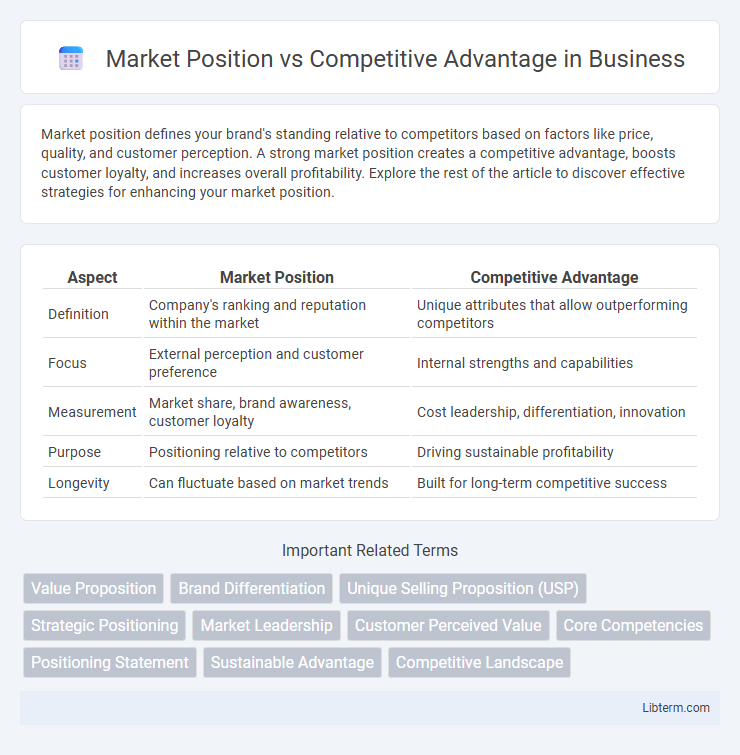Market position defines your brand's standing relative to competitors based on factors like price, quality, and customer perception. A strong market position creates a competitive advantage, boosts customer loyalty, and increases overall profitability. Explore the rest of the article to discover effective strategies for enhancing your market position.
Table of Comparison
| Aspect | Market Position | Competitive Advantage |
|---|---|---|
| Definition | Company's ranking and reputation within the market | Unique attributes that allow outperforming competitors |
| Focus | External perception and customer preference | Internal strengths and capabilities |
| Measurement | Market share, brand awareness, customer loyalty | Cost leadership, differentiation, innovation |
| Purpose | Positioning relative to competitors | Driving sustainable profitability |
| Longevity | Can fluctuate based on market trends | Built for long-term competitive success |
Understanding Market Position
Market position refers to a company's rank or standing within its industry based on market share, customer perception, and product differentiation. It reflects how consumers view the brand compared to competitors and influences purchasing decisions through factors like price, quality, and service. Understanding market position enables businesses to identify strengths, address weaknesses, and formulate strategies that enhance visibility and customer loyalty in crowded markets.
Defining Competitive Advantage
Competitive advantage refers to the unique strengths or attributes that allow a company to outperform its competitors in the marketplace. It includes factors such as cost leadership, product differentiation, innovation, and customer service excellence. Defining competitive advantage involves identifying these distinct capabilities that provide superior value to customers and create barriers to entry for rivals.
Key Differences Between Market Position and Competitive Advantage
Market position refers to a company's standing or rank within a specific industry or market based on factors like market share, brand recognition, and customer perception. Competitive advantage is the unique attribute or capability that allows a company to outperform competitors, such as cost leadership, superior technology, or exclusive resources. The key difference lies in market position reflecting relative status in the marketplace, while competitive advantage represents the strategic foundation enabling sustained superior performance.
Factors Influencing Market Position
Market position is shaped by factors such as brand reputation, customer loyalty, pricing strategies, product quality, and market share within a specific industry. External elements like economic conditions, competitor actions, and regulatory environment also significantly impact a company's standing in the marketplace. Effective understanding and leverage of these variables help businesses establish a strong foothold and differentiate their market presence.
Building a Sustainable Competitive Advantage
Building a sustainable competitive advantage requires leveraging unique resources and capabilities that are difficult for competitors to imitate or substitute, such as proprietary technology, strong brand equity, and exclusive partnerships. Market position reflects a company's current standing relative to competitors, but maintaining dominance depends on continuous innovation, customer loyalty, and cost leadership to defend against market shifts. Firms that integrate strategic assets with adaptive operational practices can sustain profitability and long-term market relevance despite competitive pressures.
Role of Branding in Market Position
Market position defines a brand's place in the market relative to competitors, influenced by customer perception, pricing, and product quality. Branding plays a critical role by shaping consumer perceptions, fostering loyalty, and differentiating products through unique visual identity, messaging, and values. Strong branding enhances competitive advantage by creating emotional connections and increasing market share in targeted segments.
Strategies to Strengthen Competitive Advantage
Strategies to strengthen competitive advantage include enhancing product differentiation, leveraging cost leadership through efficient operations, and investing in innovation to create unique value propositions. Building strong customer relationships via personalized marketing and superior service further solidifies market position. Continuous analysis of competitor actions and market trends enables dynamic adjustments, ensuring sustained competitive advantage.
Measuring the Impact of Market Position
Market position significantly influences a company's revenue growth, customer loyalty, and market share, which can be measured through metrics such as sales volume, brand recognition scores, and customer retention rates. Analyzing market position impact involves comparing these quantitative indicators against competitors within the same industry segments. Quantifying customer lifetime value (CLV) and net promoter score (NPS) further clarifies how well a market position translates into sustained competitive advantage and profitability.
Case Studies: Companies Excelling in Both
Market position reflects a company's standing in the industry based on factors like market share and customer perception, while competitive advantage involves unique attributes or capabilities enabling superior performance. Amazon exemplifies excelling in both through its dominant market position and innovative logistics infrastructure, driving customer loyalty and cost leadership. Similarly, Tesla combines a strong market position in electric vehicles with technological advantages in battery development and software, solidifying its industry leadership.
Aligning Market Position with Competitive Advantage for Growth
Aligning market position with competitive advantage involves leveraging unique strengths to differentiate a brand effectively within target markets, driving customer preference and loyalty. Strategic alignment enhances sustainable growth by ensuring product offerings, messaging, and value propositions resonate with core competencies that competitors cannot easily replicate. Consistent alignment supports market expansion, maximizes profitability, and solidifies a company's long-term leadership in its industry.
Market Position Infographic

 libterm.com
libterm.com